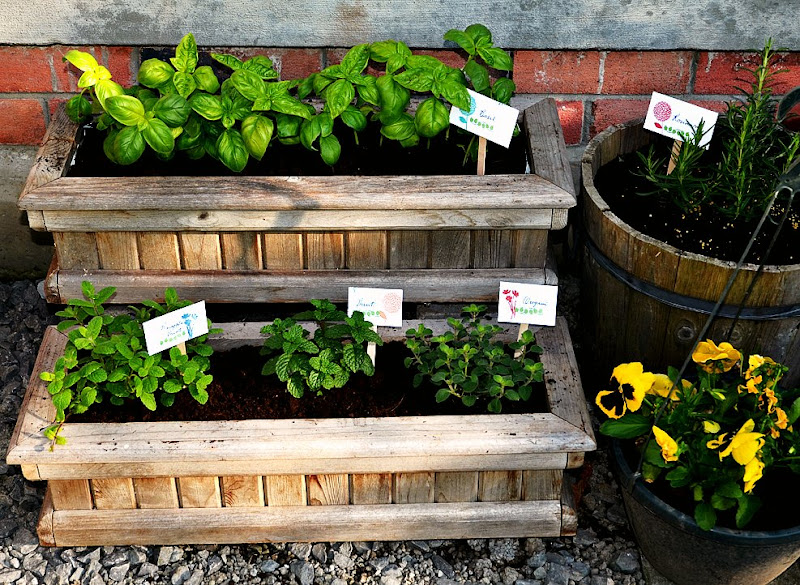Aside from the colorful flowers and nesting birds that grace our backyard in springtime, planting my herbs is the highlight of this beautiful season. Every year, on Victoria Day long weekend {celebrated every last Monday before May 25} my handsome gardener {a.k.a. as my dear hubby} would tenderly plant my favorite herbs in "mon petit jardin d'herbes aromatiques" {my little herb garden}.
I keep my herb garden to a maximum of five different herbs every year. Aside from the fact that we don't have enough space for all the herbs I fancy, we only plant what I frequently use for my summer recipes. This year I have ....
Rosemary for my grilled lamb or beef, savory scones and to die for lemon-rosemary iced tea.
Basil for my pasta dishes, pesto sauce and home-made pizza
Mint for my fresh summer fruit salad, mint-yogurt chutney, mint julep and mojito
Oregano for my Greek salad and kebob
This year, I tried this pineapple mint. I don't know yet where use them {maybe a chicken dish} but the aroma and taste look very promising.
Hubby and I are no experts. But for the past 6 years we learned some helpful tips we want to share with you if you are starting your own "petit jardin d'herbes aromatiques"
Tip #1.
Start by planting seedlings rather than planting your own seeds. We normally buy these little starter plants/herbs from Home Depot,Walmart, grocery stores with garden area or from the local nursery. They are usually available mid May and the price ranges from $2.00 to $2.50 per herb.
Tip #2
For your first small herbal garden, choose herbs that are easy to grow like basil - this is perfect trainer herb, You can also add rosemary, thyme, oregano and mint in your garden. All of these can grow indoors too. Cilantro is a hit and miss for us, so I wouldn't recommend it if you are a neophyte.
Tip #3
Good soil is a must. We always plant our herbs on pots and other containers using potting mix, rather than potting soil. Potting mix is lighter, usually made from organic matter and designed to give container plants the texture and drainage they need.
Tip #4
Make sure the pots and containers has a nice-sized hole and {if you can} add rocks at the bottom of the container for good drainage because herbs' roots can't stand sitting in too-wet soil.
Tip #5
If you recall, herbs originated in sun-drenched regions like the Mediterranean. Be sure you will choose a spot in your garden where the sun shines at least 4-8 hours a day. If your pots are indoors, they should be placed on a very sunny south-facing windowsill.
Tip #6
Herbs need watering too. But unlike ordinary houseplants that need only one solid watering per week, herbs need a moderate amount every other day particularly during the peak of summery. You can check by sticking your finger into the soil. If it feels dry an inch beneath the surface, it's time to water!
Tip #7
Feed your herbs. Add a slow-release or organic fertilizer when you plant. Some potting mixes come with slow-release fertilizer pellets already mixed in. If this is the case, fertilize after month. {Do not use fertilizer that promotes flowering}.
Tip #8
It's all about the leaves! Harvest often. Harvesting promotes growth. It keeps plants in their growing cycle instead of letting them mature and finish their life. You can harvest up to a third of the foliage. And if you see a flower, clip or pinch it off. Once an herb flowers it’s trying to finish its life cycle.
If you recall, herbs originated in sun-drenched regions like the Mediterranean. Be sure you will choose a spot in your garden where the sun shines at least 4-8 hours a day. If your pots are indoors, they should be placed on a very sunny south-facing windowsill.
Tip #6
Herbs need watering too. But unlike ordinary houseplants that need only one solid watering per week, herbs need a moderate amount every other day particularly during the peak of summery. You can check by sticking your finger into the soil. If it feels dry an inch beneath the surface, it's time to water!
Tip #7
Feed your herbs. Add a slow-release or organic fertilizer when you plant. Some potting mixes come with slow-release fertilizer pellets already mixed in. If this is the case, fertilize after month. {Do not use fertilizer that promotes flowering}.
Tip #8
It's all about the leaves! Harvest often. Harvesting promotes growth. It keeps plants in their growing cycle instead of letting them mature and finish their life. You can harvest up to a third of the foliage. And if you see a flower, clip or pinch it off. Once an herb flowers it’s trying to finish its life cycle.
Tip #9
Enjoy your herbs by using them in your recipes!









No comments:
Post a Comment
Thank you for your sweet words.